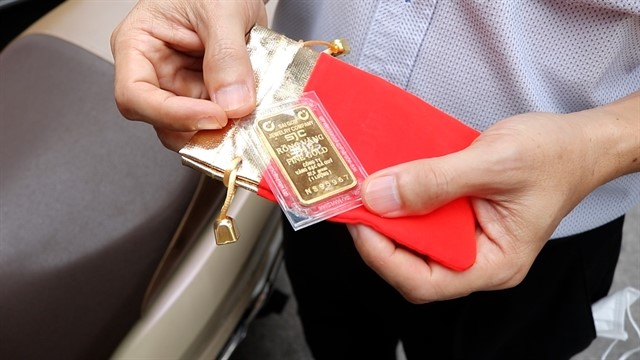More administrative tools will be introduced next week to stablise the gold market and reduce the gap between domestic and global gold prices.

After nine gold auctions, the State Bank of Vietnam (SBV) will no longer be using this measure to try and stablise the market but instead introduce other administrative tools next week, said the central bank's leader.
The goal is to reduce the gap between domestic and global gold prices, as well as to increase transparency in gold market transactions.
Speaking at the socio-ecnomic discussion session on May 29, Nguyễn Thị Hồng, the Governor of the SBV, said that recently, SJC-brand gold prices have experienced significant increases, a trend that has been observed globally across various countries.
The task of narrowing the gap between domestic and international gold prices is extremely challenging, given the continuous and volatile fluctuations in global gold prices, Hồng added.
The SBV had previously increased the gold supply to the domestic market through gold auctions, similar to actions taken in 2013, to solve the issue. The expectation was that by increasing supply, the price differential would gradually decrease.
However, after nine auction sessions, the central bank found that the price gap did not decline as anticipated. As a result, the central bank has now decided to halt the gold bidding.
Instead, SBV will directly sell gold to State-owned commercial banks, including Agribank, Vietcombank, BIDV and VietinBank, starting June 3 and the banks will sell gold to the public.
It has also made the decision to establish an inter-agency inspection team. The team will conduct a comprehensive examination, scrutinising invoices, transaction records and other aspects of the gold market. The purpose is to determine if any unlawful speculative or hoarding behaviours have contributed to the recent volatility in gold prices.
Separately, Deputy Prime Minister Lê Minh Khái noted that since June 2022, the Government and the Prime Minister have been providing close oversight and guidance to the SBV regarding the issues in the gold market.
The Deputy PM said that to address the gold market issues, a total of 25 policy documents have been compiled so far. These documents include various intervention and stabilisation tools, as well as inspection and control measures.
Looking ahead, the Government will be revising Decree 24 to make long-term structural changes.

Talking to Việt Nam News, Nguyễn Đức Hùng Linh, Founder and Chief Advisor at Think Future Consultancy & Investment, said that the directive to stabilise domestic gold prices will remain in place, though the methods may change. It's unclear if the gold bar auctions will be halted completely after June 3.
Since the details of the new stabilisation measures are unknown, the SBV may organise gold auctions in a new form. This could involve changes to the auction price determination or the participants and distribution channels.
It's important to note that gold is primarily a store of wealth, generating little benefit for production and business. Importing gold for domestic sale depletes foreign exchange reserves, which should only be used for critical needs. The reserves currently cover just three months of imports, the bare minimum. Any use of the reserves must be carefully considered.
The gap between SJC gold prices and global prices remains high, with little change from before the auctions. However, as this is an initial market test, there's no need to heavily focus on the price difference.
"We don't yet know the true market demand - aside from consumer needs, there could be speculative and hoarding factors at play. Selling gold aggressively at low prices to reduce the gap, without a clear grasp of the market, risks depleting foreign exchange reserves (for gold imports) and inadvertently benefiting speculators," Linh said.
The gold auctions are not primarily aimed at instantly reducing gold price. Rather, the goal is to gradually increase the supply of SJC gold bullion in the market to better match demand and narrow the demand-supply gap. This approach also creates a room for authorities to inspect and audit the gold market.
"However, I believe that in addition to this measure, other administrative measures and the use of monetary policy tools are also needed," Linh said.
The administrative measures here refer to inspections and audits to make the market more transparent through invoices and bank transfers. The monetary policy measure here is to raise interest rates, so that we can address, and possibly even eliminate the issue without needing to resort to excessive gold bidding.
On the market, SJC gold prices experienced strong fluctations on Thursday morning.
At 9.30am, SJC gold prices were quoted at VNĐ84.5 million per tael (US$3,319) for sellers and VNĐ88 million per tael for buyers, down VNĐ4.4 million per tael and VNĐ2.9 million, respectively, from the previous session.
However, at 11.15am, prices recovered to VNĐ86 million for sellers and VNĐ88.5 million for buyers.
The spot gold price on the international market was traded at $2,325.5/ounce, around VNĐ20.5 million lower than the domestic gold price. — VNS
- Tags
- gold market





